Categories
- Argentina
- Chile
- Antarctica
- Easter Island
- Falklands (Malvinas)
- Bolivia
- Peru
- Uruguay
- Paraguay
- Brazil
- Venezuela
- Colombia
- Ecuador
- Galapagos
- Panama
- Costa Rica
- Cuba
- Nicaragua
- Honduras
- El Salvador
- Guatemala
- Belize
- Mexico
- Latin American Xmas
Pages
- Map of South America
- Home Page
- First week in Latin America – October 2009
- Map of Central America
- Contact Us
- The Jesuit Missions in South America
- A week in Buenos Aires
- Street Art of Buenos Aires
Archives
- October 2011 (3)
- September 2011 (9)
- August 2011 (10)
- July 2011 (7)
- June 2011 (6)
- May 2011 (11)
- April 2011 (10)
- March 2011 (4)
- February 2011 (5)
- January 2011 (6)
- December 2010 (6)
- November 2010 (4)
- October 2010 (8)
- September 2010 (5)
- August 2010 (7)
- July 2010 (5)
- June 2010 (6)
- May 2010 (6)
- April 2010 (7)
- March 2010 (6)
- February 2010 (9)
- January 2010 (4)
- December 2009 (8)
- November 2009 (5)
- October 2009 (2)
San Blas Islands
04th March 2011
With a feeling of unease we handed over our passports in a bar in Cartagena (Colombia) [1] to Captain John, owner of the 18 metre yacht Wild Card which was going to take us to Panamá via the San Blas Islands. A group of 16 backpackers boarded the following evening and were soon under way, leaving the city lights behind. While we didn´t sail off into the sunset, we motored into the night – nearly the same thing.
.
Out in the open ocean the wind was 10 to 15 knots with waves of 2 to 3 metres. Pam was hurled out of our bunk during the night when a bigger wave broke over the boat. Even with sea sickness pills we were feeling terrible and wondered why we had decided to travel 180 nautical miles in open sea in the windy season. All was forgotten when the first of some 365 idyllic, mostly deserted, white sand, palm filled islands of the San Blas Archipelago [2] came into sight. What a paradise.
.
We spent 3 days moving among the islands, anchoring for snorkelling and swimming in the clear water. Out of nowhere appeared Kuna Yala indigenous in canoes with fish, octopus, lobsters and conch shells for sale as well as the colourful molas made by the women. The Kuna Yala people have autonomous control of the San Blas Islands (Kuna Yala) and allow no development – there are no hotels or resorts. They do not permit marriage to outsiders so these people remain the most traditional indian group in the Americas. The mola is part of the traditional women´s blouse still worn today. Several layers of different-colored cotton cloth are sewn together; the design is then formed by cutting away parts of each layer. The edges of the layers are then turned under and sewn down. The stitches are nearly invisible.
.
John was full of surprises, producing a cheesecake for 2 birthdays on board and cooking up lobsters one night with a delicious seafood stew he had spent hours in the galley preparing. All the seafood was so fresh it was still alive when it went into the pot.
.
All too soon it was over and we faced more rough seas to reach the mainland of Panama. We awoke in a tranquil bay of Portobelo[3] surrounded by jungle covered hills. Portobelo was founded in 1597 by the Spanish and became an important gold port.
.

Captain John on the Wild Card

Tom and Luke, the crew

The first of the San Blas Islands

Kuna Yala man fishing

Wild Card

The passengers on board

In the bunk

Beautiful islands

Lobsters for sale from the canoe

Kuna Yala women come to sell molas

Some of the colourful molas laid out on the deck

Women in Kuna Yala wrap colorful beads around their legs to create intricate and beautiful patterns

Another island

Sailing canoe

Densely packed village occupies the whole island

Village child

You could come by helicopter

John tenderises the octopus
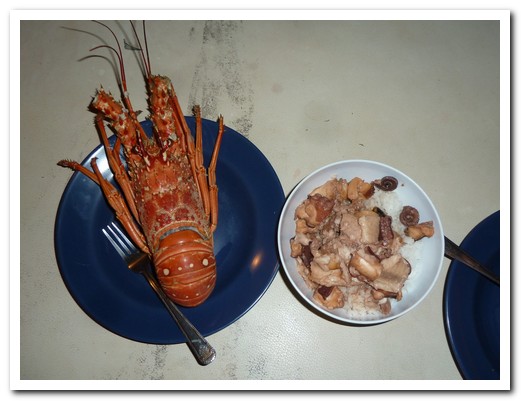
Seafood feast on the deck of Wild Card

Two of the passengers enjoying their lobsters

Happy as pigs in poo

Sailing canoe

Windswept island

Not one more coconut tree will fit on here

Going ashore on one of the islands

Sparsely populated island

One last swim

Portobelo harbour at dawn

Old customs house
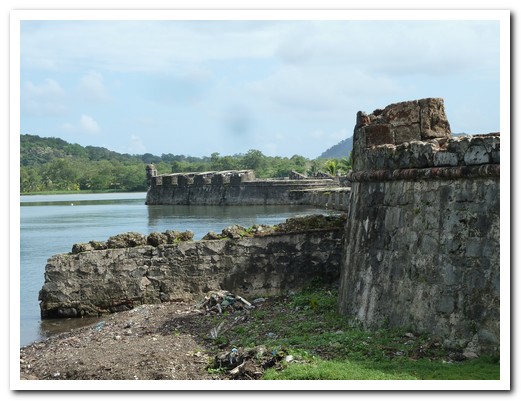
Fort at Portobelo

Cannons inside the Fort

Ocean bird

Portobelo church

Lady selling and wearing molas
Panamá City
08th March 2011
Panamá City [4] was a very pleasant place to spend a week. We were surprised how cosmopolitan it is. Locals joke Panamá City is the “Miami of the south, except we speak more English”. With an apartment we were able to spread ourselves out, cook healthy meals for a change and drink wine in our pyjamas.
.
Across the bay from the skyscrapers of the modern city, the Casco Viejo (old compound) juts out on a rocky peninsula. Crumbling buildings stand beside beautifully restored gems along the narrow streets. Nearby is the Mercado de Mariscos where the freshest of seafood is sold. Fresh homemade spicy picante sauce is a perfect accompaniment. Panamá Viejo (old Panamá), the original city which was destroyed by the pirate Henry Morgan in 1671 lies in impressive and nostalgic ruins 8 kilometres away.
.
Carnival was on – in the mornings, water is sprayed on the crowds from giant water tankers, whilst the nighttimes are given to serious partying. One of the days is dedicated to the pollera, the voluminous, colourful skirt traditionally worn by Panamanian women. Many of the Canal workers came from the West Indies and their Antillean Fair celebrates all things African in the Caribbean featuring food (we loved the Chombo chicken), handicrafts and dancing.
.
We headed out to the Miraflores Locks (live WebCam) on the Panamá Canal where we saw a large container ship going through the locks – very impressive.
.

The view of modern Panamá City from Panamá Viejo
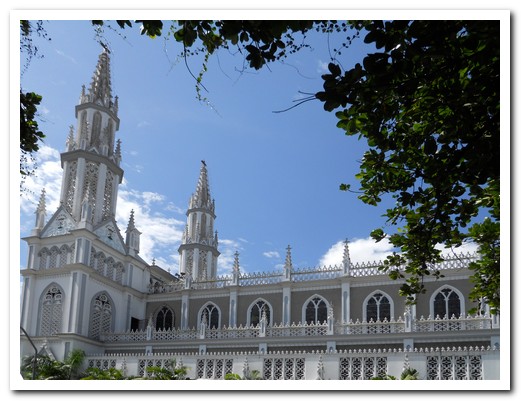
A church in Panamá City

Statue of Balboa, the first European to see the Pacific Ocean (1513)

The Cathedral in Casco Viejo

There are quite a few shanties in Casco Viejo

Ruins of the Jesuit Church

Beautifully restored and abandoned buildings on the waterfront

Trees growing through the windows of this old house

Another dilapidated place

A couple of musicians

Jeff buying dinner at the fish market - large prawns go for $12 a kilo

Ruins of the Cathedral tower at Panamá Viejo

Cistern

Jesuit Church

Convent

One of the Carnaval floats

That´s a water pistol!




Polleras (Panamá skirts)

Devil at the Carnaval

Maypole dance at the Antillean Fair

Locks closing on a ship in the Canal
The Rest of Panamá
15th March 2011
West of Panamá City, nestled in the giant crater of an extinct volcano is El Valle de Antón [5]. Famous for square trees which only exist here in the mountain village and several species of endemic orchids, it is also home to the endangered golden frog. Petroglyphs just out of town remain to be deciphered.
.
The cool climate of Boquete [6] 1000 meters up in the western highlands of Panama, make it the perfect place to grow coffee. Due to landslides we were unable to hike in the surrounding mountains, a pity because there was a chance to see the quetzal birds. From Boquete we took a couple of chicken buses and then a boat to Bocas.
.
To finish off with Panama, we spent a few days relaxing on Isla Colón [7] in the Bocas del Toro Archipelago. When Columbus arrived in 1502 on his 4th voyage, he repaired his ship and named the islands: Carenero (repair a ship), and Colón (Colombus in Spanish) after himself. The small town had a laid back Caribbean atmosphere. The people speak English but with the accent of Jamaica, mon. We stayed in an old wooden hotel with creaking floorboards built out over the sea many years ago. There is nothing quite like an early morning swim off the back deck followed by a breakfast of fresh fruits, well except maybe an evening swim followed by a cold beer.
.

Endangered Golden Frog
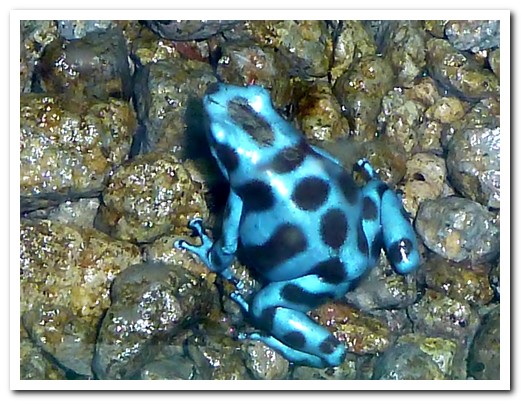
Another colourful frog

And another

Friendly monkey

Church at El Valle de Antón
 |
 |
 |
 |
 |
 |

Square tree

Petroglyphs, yet to be deciphered
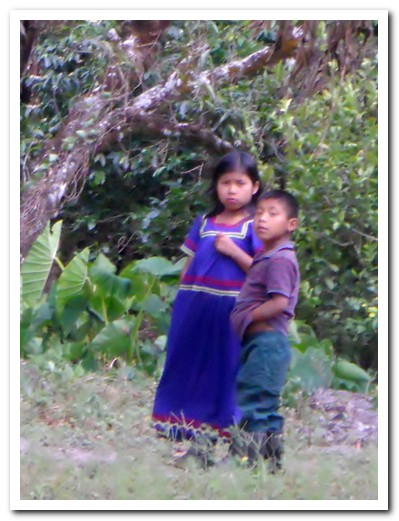
Local women and girls wear bright clothing ...

... around Bloquete

Can I share this seat on the bus with your chickens?

A house on the way to Isla Colón

Local man fishing

Our Hotel Dos Palmas from the sea

Typical restaurant over the water

One of the Bocas del Toro islands

Beautiful palm fringed beaches on Carenero where Colombus repaired his ship

Ibis looking for food

Tropical jungle meets the ocean
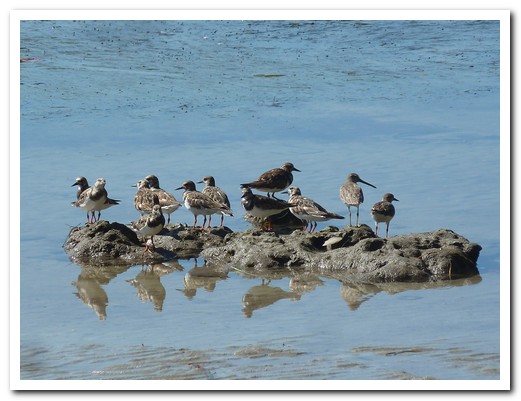
A group of sea birds

Strange roots near the sea